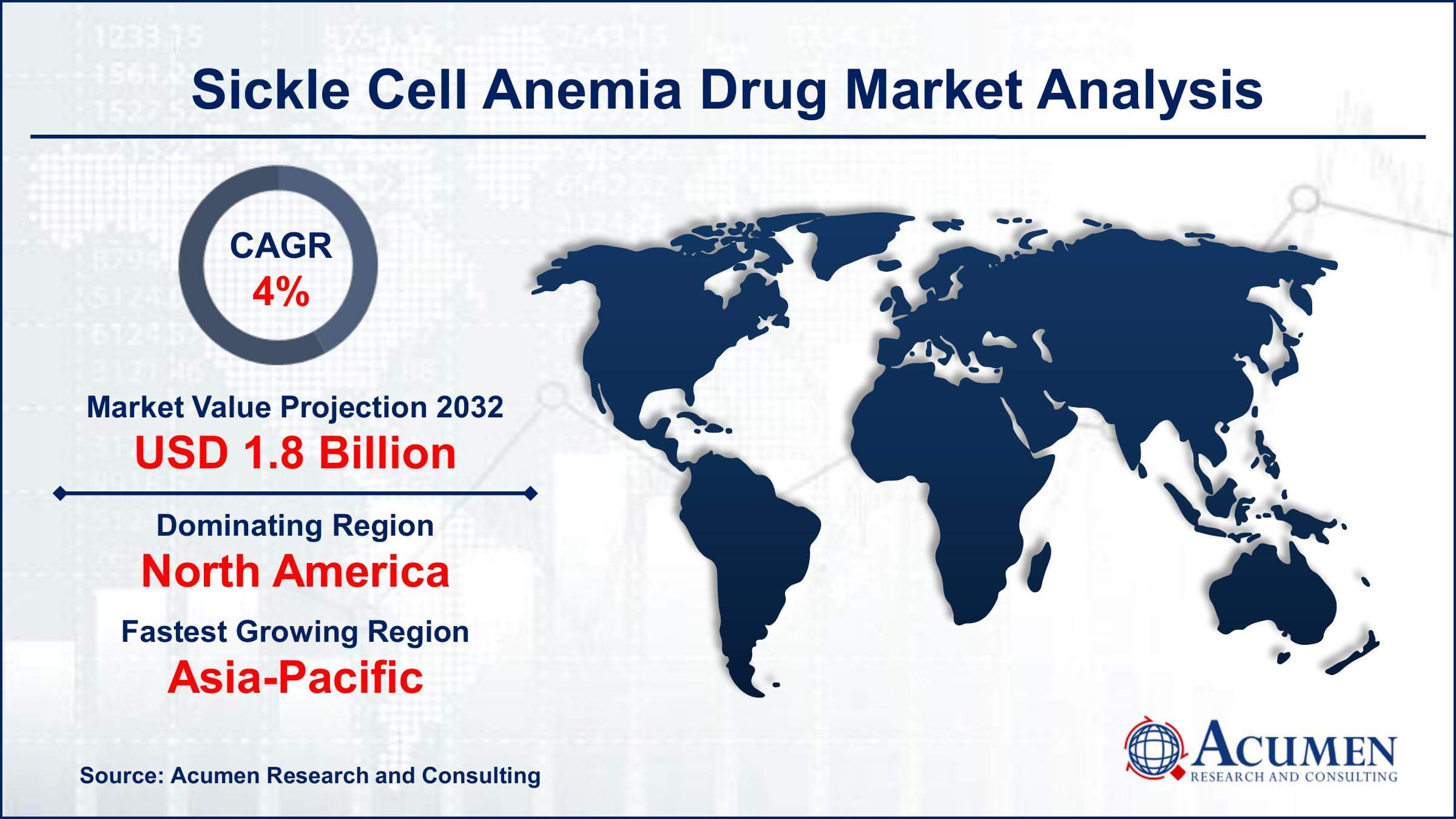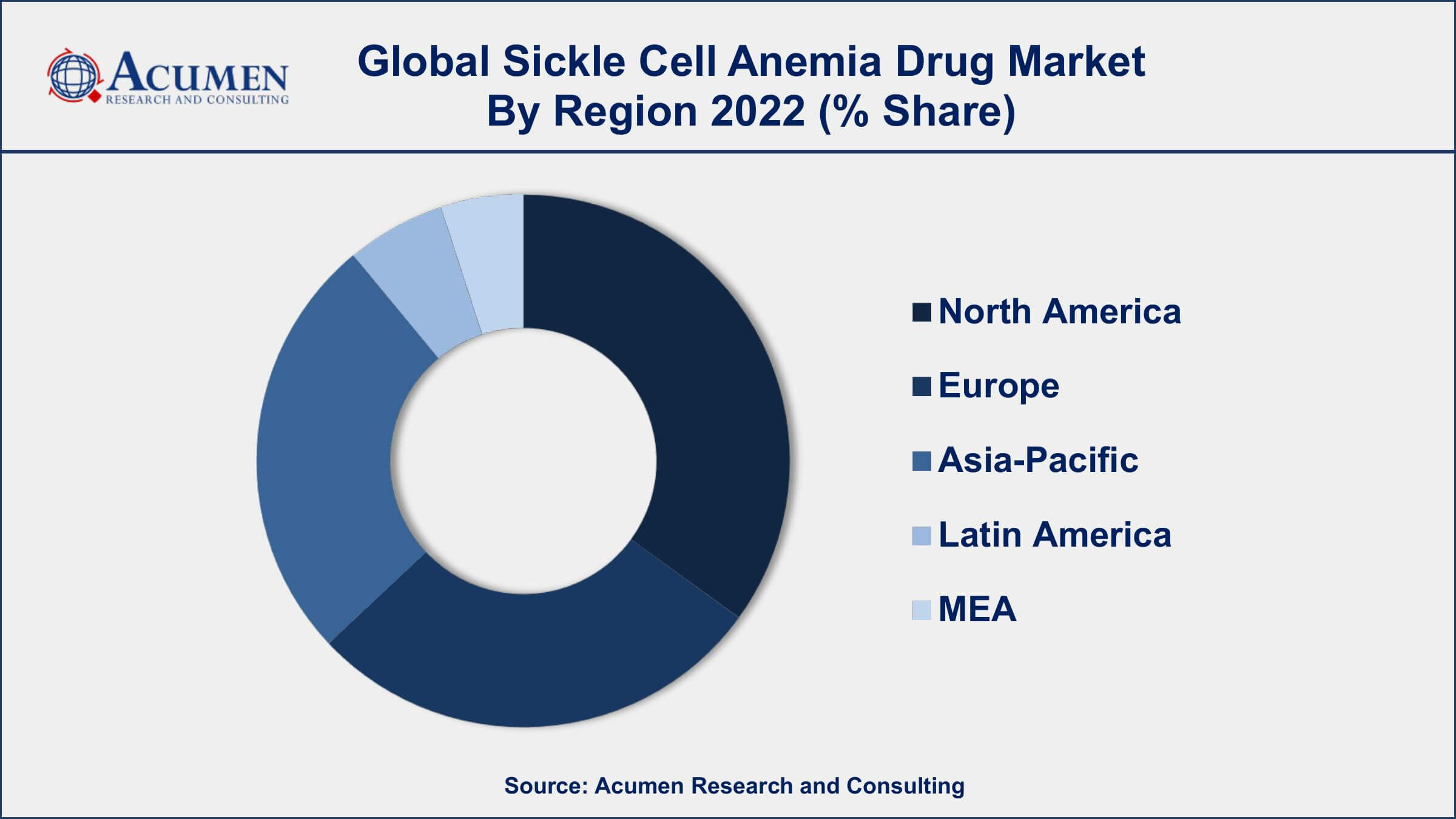Sickle Cell Anemia Drug Market Size - Global Industry, Share, Analysis, Trends and Forecast 2023 - 2032
Published :
Report ID:
Pages :
Format :
Sickle Cell Anemia Drug Market Size - Global Industry, Share, Analysis, Trends and Forecast 2023 - 2032
Report Coverage
- Industry Dynamics
- Market Size and Forecast Data
- Segment Analysis
- Competitive Landscape
- Regional Analysis with a Niche Focus on Country-Level Data
- High Level Analysis - Porter's, PESTEL, Value Chain, etc.
- Company Profiles of Key Players
- Option to Customize the Report As Per Your Specific Need
Request Sample Report
The Global Sickle Cell Anemia Drug Market Size accounted for USD 1.2 Billion in 2022 and is projected to achieve a market size of USD 1.8 Billion by 2032 growing at a CAGR of 4% from 2023 to 2032.
Sickle Cell Anemia Drug Market Key Highlights
- Global sickle cell anemia drug market revenue is expected to increase by USD 1.8 Billion by 2032, with a 4% CAGR from 2023 to 2032
- North America region led with more than 39% of sickle cell anemia drug market share in 2022
- According to the Centers for Disease Control and Prevention (CDC), sickle cell anemia affects approximately 100,000 people in the United States, and millions of people worldwide
- Asia-Pacific sickle cell anemia drug market growth will record a CAGR of over 4.6% from 2023 to 2032
- As per a clinical trial, hydroxyurea reduced the number of pain crises by 50% in people with sickle cell anemia
- Increasing prevalence of sickle cell anemia, drives the sickle cell anemia drug market value

Sickle cell anemia is a genetic blood disorder that affects the hemoglobin in red blood cells. The abnormal hemoglobin causes the red blood cells to become rigid and form a crescent or sickle shape, which can block blood flow and cause pain and other complications. While there is no cure for sickle cell anemia, there are drugs that can help manage the symptoms and improve the quality of life for patients.
The sickle cell anemia drug market has been growing steadily in recent years due to an increase in the prevalence of the disease and a greater focus on developing effective treatments. Some of the key drugs used to treat sickle cell anemia include hydroxyurea, which can reduce the frequency of painful crises, and blood transfusions, which can improve oxygen delivery to tissues. In addition, there are several promising therapies in development, such as gene therapy and bone marrow transplant. The global sickle cell anemia drug market is expected to continue growing in the coming years, driven by factors such as increasing awareness of the disease, rising healthcare expenditure, and ongoing research and development efforts.

Global Sickle Cell Anemia Drug Market Trends
Market Drivers
- Increasing prevalence of sickle cell anemia
- Growing awareness of the disease and its management
- Advancements in technology for drug development
- Government initiatives and funding to support research and development
Market Restraints
- High cost of treatment and limited insurance coverage
- Limited availability of treatment options in certain regions
Market Opportunities
- Development of novel therapies such as gene therapy and bone marrow transplant
- Focus on personalized medicine and precision therapeutics
Sickle Cell Anemia Drug Market Report Coverage
| Market | Sickle Cell Anemia Drug Market |
| Sickle Cell Anemia Drug Market Size 2022 | USD 1.2 Billion |
| Sickle Cell Anemia Drug Market Forecast 2032 | USD 1.8 Billion |
| Sickle Cell Anemia Drug Market CAGR During 2023 - 2032 | 4% |
| Sickle Cell Anemia Drug Market Analysis Period | 2020 - 2032 |
| Sickle Cell Anemia Drug Market Base Year | 2022 |
| Sickle Cell Anemia Drug Market Forecast Data | 2023 - 2032 |
| Segments Covered | By Drug Type, By Distribution channel, And By Geography |
| Regional Scope | North America, Europe, Asia Pacific, Latin America, and Middle East & Africa |
| Key Companies Profiled | Novartis International AG, Global Blood Therapeutics Inc., Emmaus Life Sciences Inc., Bristol Myers Squibb, Bluebird Bio Inc., Pfizer Inc., Sanofi SA, Imara Inc., Sangamo Therapeutics Inc., Gamida Cell Ltd., Intellia Therapeutics Inc., and Editas Medicine Inc. |
| Report Coverage |
Market Trends, Drivers, Restraints, Competitive Analysis, Player Profiling, Covid-19 Analysis, Regulation Analysis |
Sickle cell disease is an inherited group of the syndrome in which RBCs twist to a sickle shape. A cluster of syndromes causes red blood cells (RBCs) to become distorted and break down. Some of the common symptoms of sickle cell disease are pain, infection, and fatigue. Popular treatments for this disease include rarely a bone-marrow transplant, blood transfusions, and medication.
The growing geriatric population in major economies and rising healthcare spending and demand for drug therapy in combination with blood transfusion and surgeries are driving the market growth. In addition, the overall cost of sickle cell disease diagnosis is reduced, which in turn, is majorly influencing the market growth. However, adverse effects from sickle cell anemia such as intravenous catheter-associated infections, liver in-toxicity, and low hemoglobin are impeding the growth of this market. Government emphases on spreading awareness about sickle cell anemia cure combined with augmentation of FDA-approved drug accessibility are propelling the market expansion over the forecast period.
Sickle Cell Anemia Drug Market Segmentation
The global sickle cell anemia drug market segmentation is based on drug type, distribution channel, and geography.
Sickle Cell Anemia Drug Market By Drug Type
- Hydroxyurea
- Iron chelation therapy
- Blood transfusion therapy
- Bone marrow transplant
- Gene therapy
In terms of drug types, the hydroxyurea segment has seen significant growth in the recent years. It works by increasing the production of fetal hemoglobin, which can help prevent the formation of sickle-shaped red blood cells and reduce the frequency and severity of painful crises. Hydroxyurea has been shown to improve quality of life, decrease hospitalizations, and increase survival rates in patients with sickle cell anemia. The hydroxyurea segment has been growing steadily in recent years due to the drug's proven efficacy and increasing adoption by healthcare professionals. In addition, there have been several clinical trials and studies that have demonstrated the long-term safety and effectiveness of hydroxyurea in managing sickle cell anemia. The drug is also relatively affordable compared to some of the newer therapies in development, which has helped to drive demand and market growth.
Sickle Cell Anemia Drug Market By Distribution channel
- Hospital pharmacies
- Retail pharmacies
- Online pharmacies
According to the sickle cell anemia drug market forecast, the hospital pharmacies segment is expected to witness significant growth in the coming years. Hospital pharmacies play a crucial role in the market as they are responsible for providing medications and treatments to patients admitted to hospitals. Many sickle cell anemia patients require hospitalization at some point due to complications such as acute pain crises, infections, or organ damage. As such, hospital pharmacies are an important distribution channel for sickle cell anemia drugs. The hospital pharmacies segment has been growing steadily in recent years due to factors such as the increasing prevalence of the disease and rising demand for effective treatments. In addition, there has been a greater emphasis on optimizing drug management protocols for sickle cell anemia patients in hospital settings to improve outcomes and reduce costs. This has led to greater adoption of evidence-based treatment guidelines and the use of specialized pharmacy services such as clinical pharmacists and medication therapy management programs.
Sickle Cell Anemia Drug Market Regional Outlook
North America
- U.S.
- Canada
Europe
- U.K.
- Germany
- France
- Spain
- Rest of Europe
Asia-Pacific
- India
- Japan
- China
- Australia
- South Korea
- Rest of Asia-Pacific
Latin America
- Brazil
- Mexico
- Rest of Latin America
The Middle East & Africa
- South Africa
- GCC Countries
- Rest of the Middle East & Africa (ME&A)

Sickle Cell Anemia Drug Market Regional Analysis
North America is currently dominating the sickle cell anemia drug market due to several key factors. One of the primary reasons is the high prevalence of the disease in the region, particularly among African Americans. According to the Centers for Disease Control and Prevention (CDC), sickle cell anemia affects approximately 100,000 people in the United States alone. This has led to a greater focus on developing and adopting effective treatments for the disease. In addition, North America has a well-developed healthcare infrastructure and regulatory framework, which has facilitated the development and approval of new drugs for sickle cell anemia. There are several drugs that have been approved by the US Food and Drug Administration (FDA) for the treatment of sickle cell anemia, including hydroxyurea, L-glutamine, and crizanlizumab. These drugs are widely available and covered by insurance in many parts of North America, which has helped to drive demand and market growth. Furthermore, there is a strong focus on research and development in North America, with many leading pharmaceutical companies and academic institutions actively engaged in developing new therapies for sickle cell anemia.
Sickle Cell Anemia Drug Market Player
Some of the top sickle cell anemia drug market companies offered in the professional report include Novartis International AG, Global Blood Therapeutics Inc., Emmaus Life Sciences Inc., Bristol Myers Squibb, Bluebird Bio Inc., Pfizer Inc., Sanofi SA, Imara Inc., Sangamo Therapeutics Inc., Gamida Cell Ltd., Intellia Therapeutics Inc., and Editas Medicine Inc.
Frequently Asked Questions
What was the market size of the global sickle cell anemia drug in 2022?
The market size of sickle cell anemia drug was USD 1.2 Billion in 2022.
What is the CAGR of the global sickle cell anemia drug market from 2023 to 2032?
The CAGR of sickle cell anemia drug is 4% during the analysis period of 2023 to 2032.
Which are the key players in the sickle cell anemia drug market?
The key players operating in the global market are including Novartis International AG, Global Blood Therapeutics Inc., Emmaus Life Sciences Inc., Bristol Myers Squibb, Bluebird Bio Inc., Pfizer Inc., Sanofi SA, Imara Inc., Sangamo Therapeutics Inc., Gamida Cell Ltd., Intellia Therapeutics Inc., and Editas Medicine Inc.
Which region dominated the global sickle cell anemia drug market share?
North America held the dominating position in sickle cell anemia drug industry during the analysis period of 2023 to 2032.
Which region registered fastest CAGR from 2023 to 2032?
Asia-Pacific region exhibited fastest growing CAGR for market of sickle cell anemia drug during the analysis period of 2023 to 2032.
What are the current trends and dynamics in the global sickle cell anemia drug industry?
The current trends and dynamics in the sickle cell anemia drug industry include increasing prevalence of sickle cell anemia, growing awareness of the disease and its management, and advancements in technology for drug development.
Which drug type held the maximum share in 2022?
The hydroxyurea drug type held the maximum share of the sickle cell anemia drug industry.



